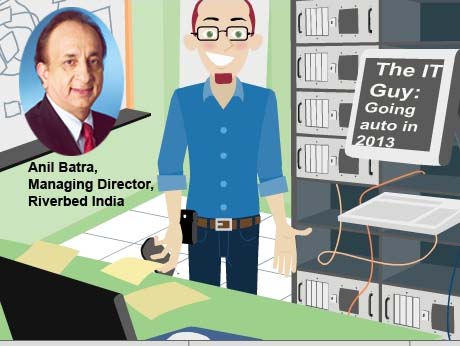
Riverbed, the IT performance company, has outlined some technology trends - ranging from developments in big data, to software-defined networks, virtualization, cloud and stateless branches. Here is the Riverbed view on what 2013 will look like, spelled out by Anil Batra, Managing Director, Riverbed India enclosed.
1. Virtualization extends to the edge: Virtualization of data centres has caused a ripple effect and will be increasingly making its way to the edge of the organization in 2013. Virtualization technology has enabled enterprises to create multipurpose “branch office boxes,” completely eliminating the need for conventional remote servers.
2. The Stateless Branch becomes a reality for more enterprises: In parallel with consolidation within a branch, advances in technology allow enterprises to build “stateless branch” offices. Achieving 100 percent consolidation of edge servers, applications and data into the data centre lets IT more effectively secure, manage and protect its resources.
3. Software-Defined Networks & Data Centres come into sharper focus: As enterprises look for ways to increase automated, policy-based computing, a programmable infrastructure enables enterprises to visualize and control their network with their own tools and in essence “program” their network with their own parameters. With software-defined networking and software-defined data centres, more enterprises will begin strategizing how they will build out their future data centres in 2013 so that they can rapidly and dynamically carve up their network and data centre as needed. By creating entire functioning ensembles of servers and networking on the fly to meet changing business demands, these new networks and data centres are offering up a level of flexibility and nimbleness that is not available with traditional networks and data centres.
4. Mobility becomes more pervasive: There will be greater penetration of mobile devices in enterprises than fixed access devices in 2013. With the availability of 802.11n Wi-Fi and further enhancements coming such as 802.11ac in 2013 as well as mobile networks increasingly using 4G, the typical office will be wireless soon. More enterprises will also inevitably need to incorporate BYOD policies into its IT planning, especially as enterprises plan and manage BYOD as it converges with virtual desktops adoption.
5. Disaster Recovery becomes highly automated: Disaster recovery will become more automated with simplification of processes and failover in mind in 2013. More organizations are upgrading networking connections to remote offices and adding SANs with virtual servers so they can replicate critical data to these branch locations. Other enterprises are choosing to move to the cloud as providers are continuing to make it an even more affordable option. DR in the cloud is also gaining momentum as cloud storage is being leveraged as a dedicated DR site.
6. Cloud drives cross-functional teams: Enterprises are rapidly adopting virtualization and cloud architectures to consolidate and reduce costs, increase flexibility and efficiency, and dynamically deliver services to end users. In 2013, more enterprises will assemble cross-functional IT groups across computing, storage and networking teams for both troubleshooting and achieving predictable, reliable delivery of applications.
7. Virtual Desktop Infrastructure adoption gains momentum: Finding a cost-effective and reliable way to manage end users in the branch office has become a priority for many organizations. A growing number of organizations view the centralization and management of branch environments through desktop virtualization as an effective approach to streamline desktop and application management while improving security, meeting regulatory requirements, and increasing flexibility and productivity. As virtual desktop performance improves, more enterprises will consider it.
8. Advances in Software as a Service (SaaS) leads to better integration & workflow services: Today, enterprises have predominantly adopted monolithic SaaS suites. In 2013, we’ll begin to see value-added SaaS integration and workflow services to create more of a dynamic environment that offers real-time management of end users, application components and IT environments such as multiple or distributed cloud platforms.
9. Big Data leads to Federation: Big data is driving an analytics movement in the network. More organizations will look for ways to consolidate as well as looking to invest in federation solutions, especially those that are cloud-based, to abstract, gather, transform and combine internal and external data from different physical locations and storage types into a consistent format.
10. Scalability continues to concern enterprises: We will see unprecedented levels of data, traffic, users and devices in 2013. Factors including consolidation, video, cloud, DR and organic growth, will drive enterprises to better allocate bandwidth, prioritize traffic and address latency. Dec 31 2012